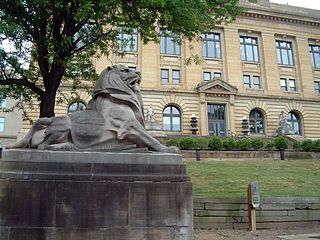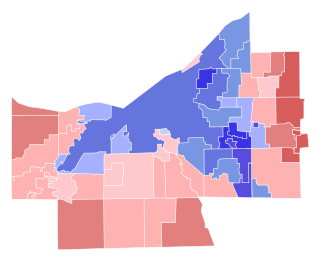
Summit County is an urban county in the U.S. state of Ohio. As of the 2020 census, the population was 540,428, making it the fourth-most populous county in Ohio. Its county seat and largest city is Akron. The county was formed on March 3, 1840, from portions of Medina, Portage and Stark Counties. It was named Summit County because the highest elevation on the Ohio and Erie Canal is located in the county.

Cuyahoga County is a large urban county located in the northeastern part of the U.S. state of Ohio. It is situated on the southern shore of Lake Erie, across the U.S.-Canada maritime border. As of the 2020 census, its population was 1,264,817, making it the second-most-populous county in the state.

Hopatcong is a borough in Sussex County, in the U.S. state of New Jersey. As of the 2020 United States census, the borough's population was 14,362, a decrease of 785 (−5.2%) from the 2010 census count of 15,147, which in turn reflected a decline of 741 (−4.7%) from the 15,888 counted in the 2000 Census.

Alpha is a borough in Warren County, in the U.S. state of New Jersey. As of the 2020 United States census, the borough's population was 2,328, a decrease of 41 (−1.7%) from the 2,369 enumerated at the 2010 census, which in turn reflected a decline of 113 (−4.6%) from the 2,482 counted at the 2000 census.

The Georgia General Assembly is the state legislature of the U.S. state of Georgia. It is bicameral, consisting of the Senate and the House of Representatives.

The New Jersey Legislature is the legislative branch of the government of the U.S. state of New Jersey. In its current form, as defined by the New Jersey Constitution of 1947, the Legislature consists of two houses: the General Assembly and the Senate. The Legislature meets in the New Jersey State House, in the state capital of Trenton.

The Metropolitan King County Council, the legislative body of King County, Washington, consists of nine members elected by district. The Council adopts laws, sets policy, and holds final approval over the budget. Its current name and structure is the result of a merger of King County and the Municipality of Metropolitan Seattle, better known as Metro, which was a federated county-city structure responsible for water quality and public transportation.

The Seattle City Council is the legislative body of the city of Seattle, Washington. The Council consists of nine members serving four-year terms, seven of which are elected by electoral districts and two of which are elected in citywide at-large positions; all elections are non-partisan. It has the sole responsibility of approving the city's budget, and develops laws and policies intended to promote the health and safety of Seattle's residents. The Council passes all legislation related to the city's police, firefighting, parks, libraries, and electricity, water supply, solid waste, and drainage utilities. (The mayor of Seattle is not considered part of council.)

Ohio county government is the structure of official managerial and legal bodies of the counties of Ohio, USA. It is marked by a loose organization and a diffusion of power, the basic framework not having been changed since the nineteenth century. The Ohio Constitution allows counties to set up a charter government as many cities and villages do, but only Summit and Cuyahoga counties have done so. Counties operating under a constitutional government do not possess home rule powers and can do only what has been expressly authorized by the Ohio General Assembly. However, Article X of the Ohio Constitution gives county government benefits similar to those conferred on cities and villages under the home rule amendments of 1912.

The San Francisco Board of Supervisors is the legislative body within the government of the City and County of San Francisco.

The government of the U.S. State of Oklahoma, established by the Oklahoma Constitution, is a republican democracy modeled after the federal government of the United States. The state government has three branches: the executive, legislative, and judicial. Through a system of separation of powers or "checks and balances," each of these branches has some authority to act on its own, some authority to regulate the other two branches, and has some of its own authority, in turn, regulated by the other branches.

The County Executive of Cuyahoga County, the second largest county in Ohio, and the 29th largest county by population in the United States, is the elected chief executive of the Cuyahoga County government. Democrat Chris Ronanye is the current county executive. The county charter stipulates that the executive is responsible for the appointment and removal of county personnel, working with other local governments, introducing legislation to the county council, submitting budgets and capital improvements plans to the council, and many other duties.

Municipal elections were held in San Diego in 2014 for city council and propositions. The primary election was held on June 3, 2014, and the general election was held on November 4, 2014. Four of the nine seats of the San Diego City Council were contested. Two city council incumbents ran for re-election in their same district and one ran for election in a new district due to redistricting.

Municipal elections were held in San Diego in 2016 for mayor, city attorney, city council, and ballot measures. The primary election was held on Tuesday, June 7, 2016, and the general election was held on Tuesday, November 8, 2016. Five of the nine council seats were contested. Two city council incumbents ran for reelection.

Shontel Monique Brown is an American politician who has served as the U.S. representative for Ohio's 11th congressional district since 2021. A member of the Democratic Party, Brown previously served as a member of the Cuyahoga County Council, representing the 9th district. She won her congressional seat in a special election on November 2, 2021, after Marcia Fudge resigned to become Secretary of Housing and Urban Development.

The 2018 Cuyahoga County executive election took place on November 6, 2018 to elect the County Executive of Cuyahoga County, Ohio. Incumbent Democratic County Executive Armond Budish won reelection to a second term with 67.47% of the vote, making him the first since the establishment of the office to be reelected.

The 2022 Cuyahoga County executive election took place on November 8, 2022, to elect the County Executive of Cuyahoga County, Ohio. Incumbent Democratic County Executive Armond Budish was eligible to run for a third term, but instead chose to retire.

The 2010 Cuyahoga County executive election took place on November 2, 2010, to elect the County Executive of Cuyahoga County, Ohio. This was the first held under the newly ratified Charter of Cuyahoga County, which replaced Cuyahoga's 200 year old Board of County Commissioners with an executive and legislature, establishing the office of County Executive.

The 2014 Cuyahoga County Council election was held on November 4, 2014 to elect members of the County Council of Cuyahoga County, Ohio. Odd-numbered districts were up for election to four-year terms, while District 10 held a special election after the resignation of Julian Rogers in 2013 to fill out the remainder of his term.



















